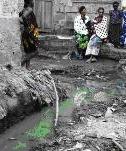
Sewage Cycle Could Clean up Slum Life, Pit Latrines in Tanzania
Pedal power may hold the answer to cheap and efficient sewage removal in some of the world’s poorest slums – if the work of a Cambridge University researcher can be taken into large-scale production.
Graduate Nate Sharpe is planning to take his "People Powered Poo Pump" to the slums of the Tanzanian capital, Dar es Salaam. Roughly 80 percent of Dar es Salaam’s 4 million residents live in slum conditions.
His trials, if successful, could revolutionize the removal of fecal sludge from pit latrines common to slums in Africa, Asia, and other parts of the developing world, according to a University of Cambridge press release.

Sharpe has designed a prototype bicycle-powered vacuum pump/tank system that works by putting the end of a hose into a pit latrine and cycling in place for a few minutes on a bike stand. This allows the sludge to be sucked into a bucket attached to the back of the bike.
He hopes the bike could become a viable business proposition for budding entrepreneurs in Dar es Salaam’s slums.
His work is featured in the latest edition of Research Horizons.
“A lot of the issues currently plaguing pit emptying services stem from the sheer volume of sludge that has to be transported. If smaller amounts could be moved more often, it becomes easy to transport – even on the back of a bicycle.”
Sharpe developed the idea for the bike while working on his degree at the Centre for Sustainable Development at Cambridge. Working with the Centre’s Heather Cruickshank, Ph.D., Sharpe’s project is one of around 35 annually that look to find innovative engineering solutions to a host of sustainability problems.
Currently working at MIT in the United States, Sharpe has combined his efforts with the team from Sanergy, who are developing low-cost latrines using a franchise model where waste is collected on a daily basis. They hope the waste produced can be used in biodigesters for heating and electricity production.
Sharpe added, “Few if any of the previous solutions take into account the economic, social, and geographical constraints found in slum areas. The prevalence of people living on less than $2 a day means they live in tightly packed, unplanned settlements.
“The pump itself costs less than $100, less than 10 percent of the next cheapest alternative. Sometimes, solutions lie not in the development of new technology, but in the creation of a new business angle that works within the local community.”